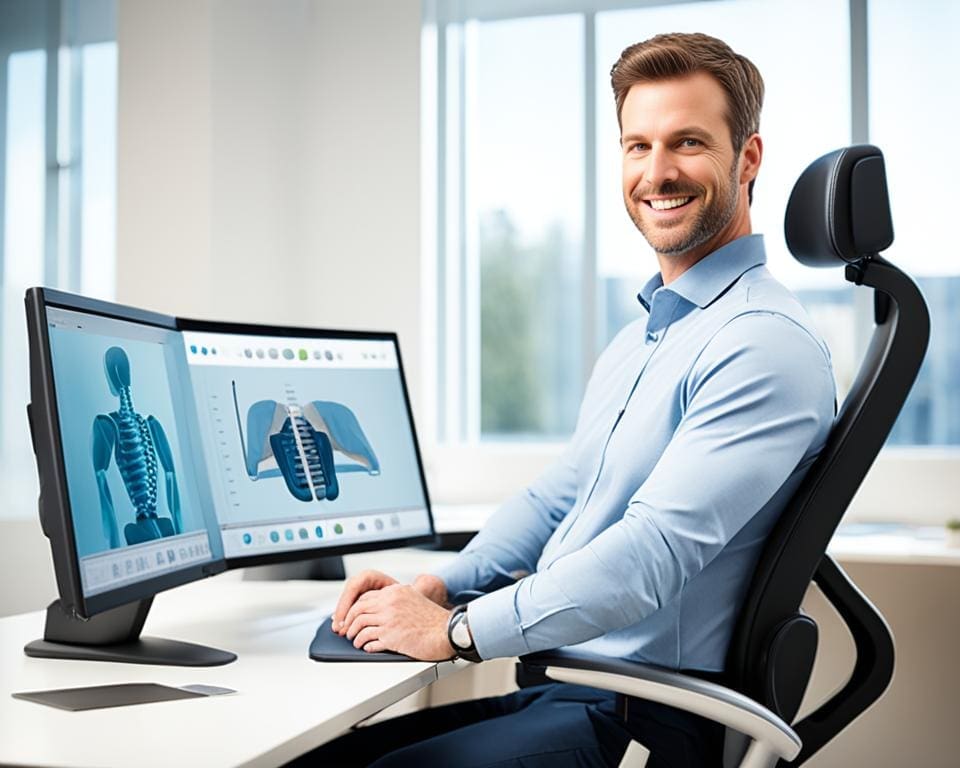The modern office boosts efficiency, creativity, and collaboration. Choosing the right furniture is key to a productive workspace. Ergonomic design is crucial for comfort and well-being. Studies show that ergonomic chairs can increase focus by up to 17.5% by improving posture and reducing discomfort.
Office layout and furniture choice encourage employees to focus on their work. Using sit-stand desks can boost task performance by 46%. Adding colour and natural designs can lift moods and spark creativity. This shows how well-planned spaces affect workplace dynamics.
Ergonomic Design: Enhancing Comfort and Focus
Understanding ergonomics is key to creating an efficient workspace. Office furniture design significantly affects employee well-being. By adopting ergonomic furniture, individuals can work more comfortably and efficiently, reducing discomfort. This is crucial as physical strain can hamper productivity. It highlights the importance of comfort and support.
Understanding Ergonomics
Ergonomics focuses on making workspaces and tools suit people’s physical needs. It aims to boost comfort and cut down health risks from sitting too long. Using comfy office furniture based on ergonomic principles can greatly benefit health and productivity.
Benefits of Ergonomic Furniture
Ergonomic office furniture offers several advantages:
- A study showed productivity jumping by 17% with ergonomic designs.
- 85% of office workers felt less discomfort and body aches with ergonomic furniture.
- There was a 25% drop in absenteeism among users of ergonomic chairs due to work injuries.
- Focus and engagement surged by 30% with ergonomic workstations.
Key Features to Look For
Consider these crucial features when picking ergonomic furniture:
- Adjustable height settings for tailored seating options.
- Lumbar support to ensure your spine stays aligned properly.
- Cushioned seating for extra comfort during long hours at work.
Examples of Ergonomic Office Chairs and Desks
There are many ergonomic options out there. Some top examples are:
- Herman Miller Aeron: Renowned for outstanding lumbar support.
- Vari Electric Standing Desk: Lets users alternate between sitting and standing, enhancing comfort and health.

Office Furniture for a Productive Workspace
Creating a pleasant and organised workspace is key to staying productive and keeping employees happy. A tidy workspace cuts down on distractions, boosting focus and work speed. Since workers spend a lot of their time at their desks, a well-organised desk is vital for success.
Importance of Organised Spaces
A tidy desk leads to a clear mind and low stress. Studies show that messy places can hurt creativity and output. With modern furniture focused on organisation, workers find it easier to handle their work. Items like multi-use furniture enhance space and workflow.
Storage Solutions for a Clutter-Free Environment
Good storage is crucial for a tidy desk area. Options like built-in cabinets and desks with drawers reduce clutter. A tidy space not only looks better but also helps with work. It lets employees concentrate on their tasks without messy distractions.
Incorporating Flexibility and Personalisation
Today’s office furniture allows for a workspace that suits each person. Letting workers personalise their space boosts comfort and drive. Things like adjustable desks and chairs help with posture, helping with health. Adding plants and art makes the space more welcoming, encouraging creative work and teamwork.
Modern Office Furniture Trends Shaping Workspaces
The way we design workspaces is changing fast. Modern office furniture is now at the heart of creating spaces that are both useful and attractive. More companies want to boost employee happiness and efficiency. They are choosing sustainable furniture to lessen their impact on the planet.
Flexible work setups, like hot-desking, have increased the need for furniture that can change easily. This flexibility helps teams work together better. It also meets different needs of workers through things like sound-soaking furniture and privacy screens. A study found 65% of UK firms are using modular designs to work more efficiently.
Choosing the right colours is also key in office design, aiming to boost creativity and concentration. A finding by the Furniture Industry Research Association revealed that 73% of UK companies plan to spend more on green office furniture by 2024’s end. This move, along with ergonomic advances reducing work-related injuries and raising productivity by 25%, proves modern office furniture’s important role in successful workspaces.









